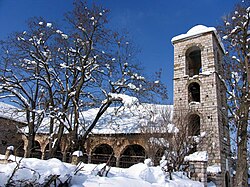St. Nicholas Church, Moscopole: Difference between revisions
AlexBachmann (talk | contribs) No edit summary Tags: Reverted Visual edit |
-> to religion not religious jurisdiction as for all religious monuments |
||
| Line 26: | Line 26: | ||
}} |
}} |
||
The '''St. Nicholas Church''' ({{langx|sq|Kisha e Shën Kollit}}; {{langx|rup|Bãserica Ayiu Nicola}}) is an |
The '''St. Nicholas Church''' ({{langx|sq|Kisha e Shën Kollit}}; {{langx|rup|Bãserica Ayiu Nicola}}) is an Orthodox church in [[Moscopole]], [[Albania]]. The church was erected in 1721.<ref name=Miropoulos>{{Cite book |
||
|last=Mikropoulos |
|last=Mikropoulos |
||
|title=Elevating and Safeguarding Culture Using Tools of the Information Society: Dusty traces of the Muslim culture |
|title=Elevating and Safeguarding Culture Using Tools of the Information Society: Dusty traces of the Muslim culture |
||
Latest revision as of 00:28, 19 November 2024
| St. Nicholas Church, Moscopole | |
|---|---|
| Native names | |
 | |
| Location | Moscopole |
| Coordinates | 40°37′54″N 20°35′22″E / 40.63155°N 20.58939°E |
The St. Nicholas Church (Albanian: Kisha e Shën Kollit; Aromanian: Bãserica Ayiu Nicola) is an Orthodox church in Moscopole, Albania. The church was erected in 1721.[1]

It is a Cultural Monument of Albania since 1948.[2]
History and description
[edit]The church was built in 1721. The structure consists of a basilica-type construction Struktura with a naos covered with a cupola, a narthex and a cloister. The interiors of the church are decorated with mural paintings executed by David Selenica and his helpers Kostandin and Kristo. The art of Selenicasi is distinguished by its realistic nature, as it is witnessed by the portrait of the donor, as well as by a deep theological knowledge. According to the inscription, the portrait of the donor the painting was finished in 1726 and this was determined by an archaeologic expedition in 1953.[3] 24 years later, in 1750, the Zografi Brothers painted the cloister.[4]
Liturgy
[edit]As of 2002, the time of the publication of a study on the Aromanians by German researcher Thede Kahl, priest Thoma was giving the Eastern Orthodox liturgy on the church in Aromanian, based on the text within the Aromanian Missal, and only thereafter in Albanian. In Aromanian, St. Nicholas is Ayiu Nicola.[5]
References
[edit]- ^ Mikropoulos, Tassos A. (2008). Elevating and Safeguarding Culture Using Tools of the Information Society: Dusty traces of the Muslim culture. Earthlab. p. 316. ISBN 978-960-233-187-3.
- ^ "Religious buildings with the "Culture Monument" status". Republic of Albania National Committee for Cult. Archived from the original on July 6, 2011. Retrieved October 28, 2010.
- ^ Th Popa; Theofan Popa (1961). Piktorët mesjetarë Shqiptarë. Ministria e Arësimit dhe Kulturës. p. 63.
- ^ Maximilien Durand (2005). Patrimoine des Balkans: Voskopojë sans frontières 2004. Somogy. p. 176. ISBN 978-2-85056-927-2.
- ^ Kahl, Thede (2002). "The ethnicity of Aromanians after 1990: the identity of a minority that behaves like a majority". Ethnologia Balkanica. 6: 157.